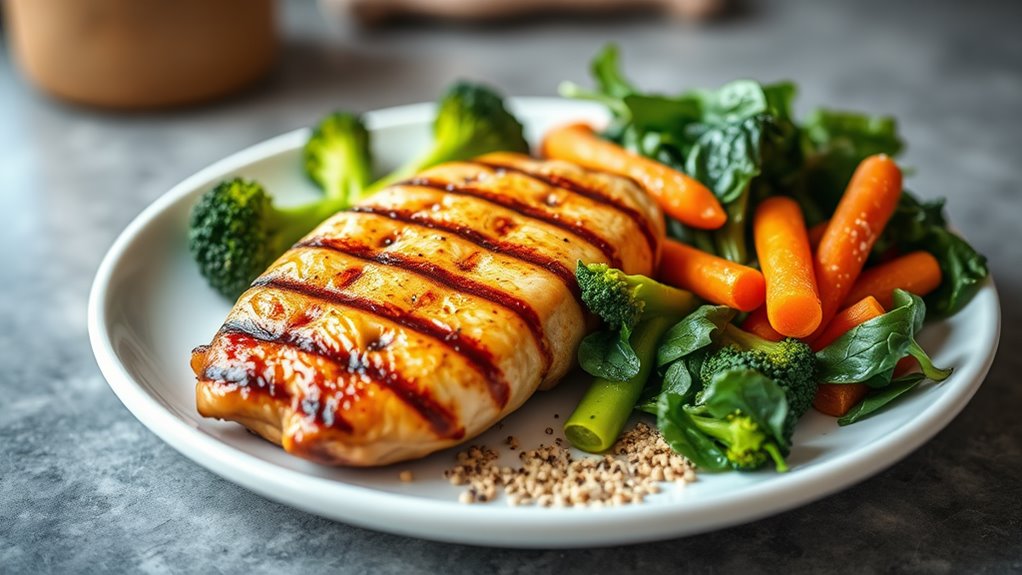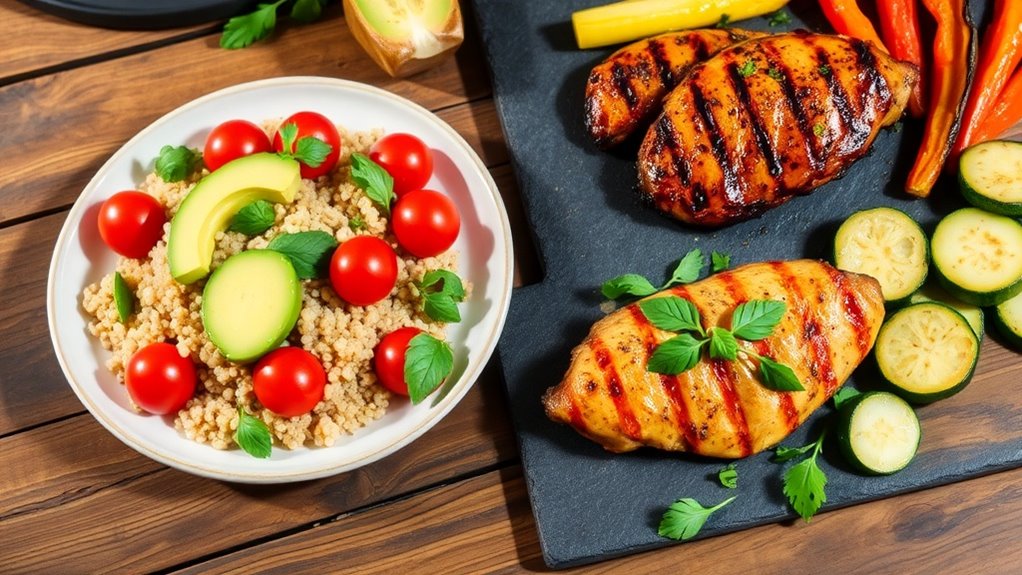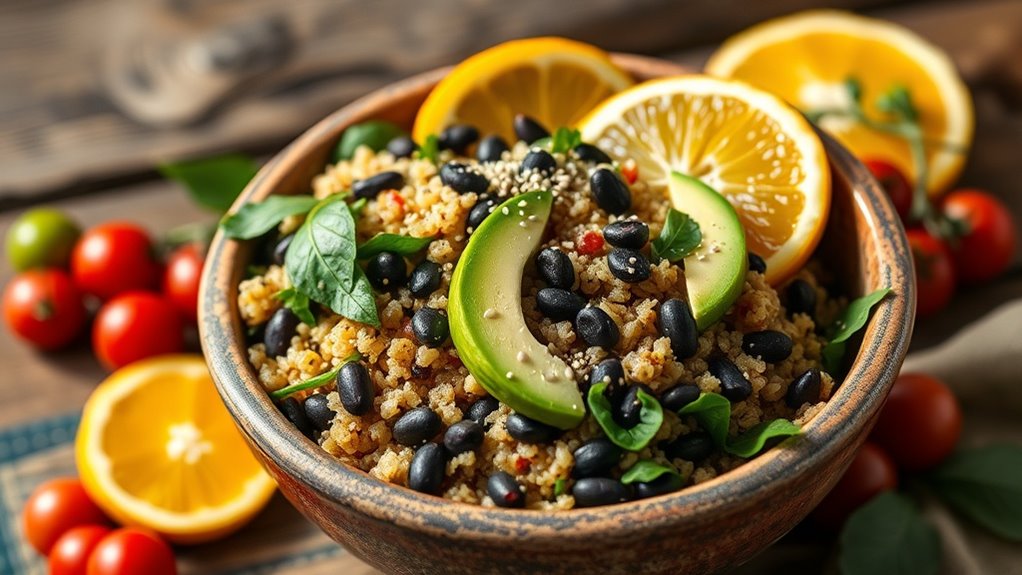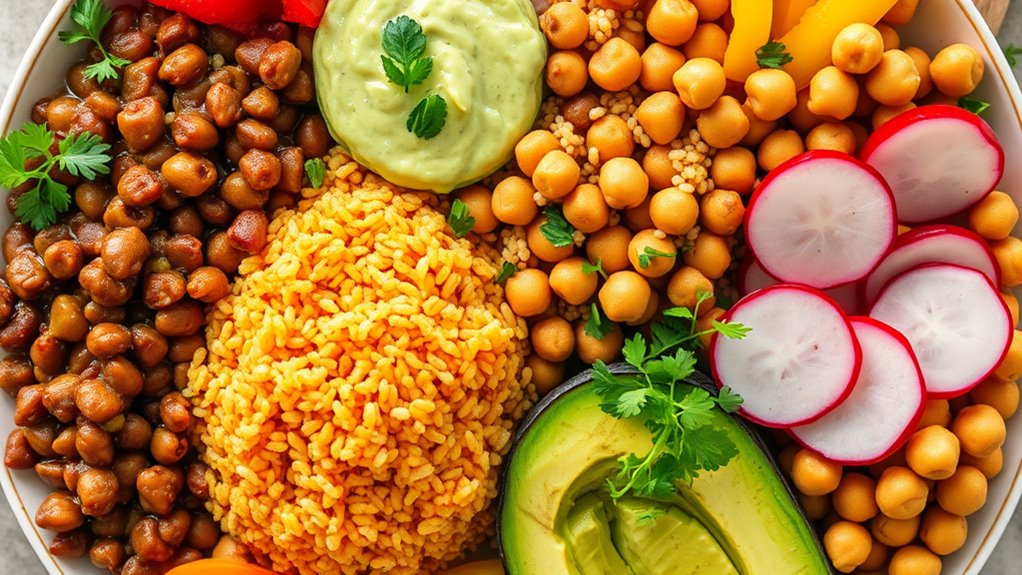Is This the Best High-Protein Meal for Your Gains.
If you’re looking for the best high-protein meal for your gains, it’s essential to include quality protein sources like lean meats, fish, eggs, or plant-based options. Aim for at least 20-30 grams of protein per serving, and don’t forget to balance it with healthy fats and complex carbs. This combination supports muscle growth and recovery, while keeping you satiated. Want to know more about specific meal ideas and prep tips? Stick around for the details!
Key Takeaways
- A high-protein meal should include at least 20-30 grams of quality protein to effectively support muscle growth and repair.
- Incorporating lean meats, fish, eggs, legumes, and dairy maximizes protein density in meals essential for muscle gains.
- Adding complex carbohydrates like quinoa aids workout recovery and fuel replenishment, enhancing overall gains from training.
- Healthy fats and fiber-rich vegetables improve nutrient absorption and digestion, promoting better overall nutritional balance.
- Consistency in meal timing and tracking protein intake helps ensure you meet daily protein goals for optimal performance and results.
Understanding Protein Needs for Muscle Growth
Understanding your protein needs for muscle growth is essential if you want to maximize your gains. To effectively harness the power of protein, you need to identify your individual requirements based on factors like body weight, activity level, and training intensity.
Aim for at least 1.6 to 2.2 grams of protein per kilogram of body weight daily; this range acts as a gains booster that fuels muscle repair and development. Timing also matters—distributing your protein intake throughout the day enhances muscle protein synthesis.
Prioritize high-quality sources, including lean meats, dairy, and plant-based options, to optimize your intake. By mastering your protein needs, you’ll set a solid foundation for impressive muscle growth and improved performance in your workouts. Remember that incorporating a high-protein meal option can further aid in achieving your muscle-building goals.
Key Ingredients of the High-Protein Meal
Once you’ve grasped your protein needs, it’s time to focus on the key ingredients that make up a high-protein meal.
Start with quality protein sources like lean meats, poultry, fish, eggs, or plant-based options like beans and lentils.
Add a healthy fat source, such as avocados or nuts, to aid absorption and enhance flavor.
Incorporate fiber-rich vegetables to support digestion and provide essential nutrients.
Don’t forget complex carbohydrates, like quinoa or brown rice, to fuel your workouts and recovery.
Finally, consider including protein supplements, such as whey or plant-based powders, to effortlessly boost your intake.
Including energizing high-protein recipes can help you sustain energy throughout the day.
Aiming for a diverse blend of these ingredients will maximize your protein intake and support your gains effectively.
Nutritional Breakdown: Calories and Macros
When crafting a high-protein meal, it’s vital to pay attention to the nutritional breakdown, particularly calories and macros.
Precision in these areas not only fuels your workouts but optimizes recovery. Here’s what you should focus on:
-
Total Calories: Know your energy needs; adjust for your activity level.
-
Protein Content: Aim for at least 20-30 grams per serving—essential for muscle synthesis.
-
Carbohydrates: Include quality carbs to replenish glycogen stores; around 30-50 grams is often ideal post-workout.
-
Fats: Incorporate healthy fats, keeping it balanced; 10-20 grams can enhance nutrient absorption.
Additionally, including a variety of high-protein meal options can help you enjoy nutritious dishes while achieving your dietary goals.
Benefits of Consuming High-Protein Meals
High-protein meals offer numerous benefits that can greatly enhance your fitness progress and overall health.
First, they support muscle growth and repair, ensuring your hard work in the gym translates into visible gains. By promoting satiety, high-protein meals help you manage hunger, making it easier to stick to your dietary goals.
Additionally, they can elevate your metabolism through the thermic effect of food, resulting in more calories burned during digestion. Consuming adequate protein also stabilizes blood sugar levels, preventing energy crashes that can disrupt your workouts. Moreover, incorporating tasty high-protein meals into your diet makes it easier to enjoy nutritious food choices.
Finally, a high-protein diet contributes to improved recovery times, allowing you to train harder and more frequently.
How to Incorporate This Meal Into Your Diet
Incorporating high-protein meals into your diet is easier than you might think, especially with a bit of planning.
Start by identifying the meals that suit your taste and goals. Here are a few strategies to help you integrate them effectively:
-
Plan Your Meals: Schedule your high-protein meals for the week ahead to guarantee you’re meeting your intake goals.
-
Balance Your Plate: Combine protein sources with healthy fats and carbs for peak nutrition.
-
Experiment with Recipes: Try new ways to prepare your meals to keep things exciting and varied.
-
Mind Your Portions: Tailor portion sizes to match your activity level and individual needs for better results.
Including a variety of savory protein-packed meals can also keep your food choices both enjoyable and nutritious.
Meal Prep Tips for Optimal Convenience
When it comes to meal prep, maximizing your efficiency is key.
You can save time and effort by using batch cooking strategies and knowing how to store ingredients smartly.
Let’s explore some practical tips that’ll make prepping your high-protein meals a breeze.
Batch Cooking Strategies
Although meal prepping might seem intimidating at first, it can considerably streamline your week, helping you maintain a high-protein diet with ease.
To master batch cooking, follow these essential strategies:
-
Choose versatile proteins: Cook chicken, beef, or legumes that can be used in various meals.
-
Utilize one-pot meals: Maximize flavor and minimize cleanup by preparing dishes like stir-fries or casseroles.
-
Portion wisely: Invest in quality containers for easy portion control and grab-and-go convenience.
-
Schedule cooking sessions: Dedicate specific times for cooking, ensuring you’re always stocked with nutrient-dense options.
With these strategies, you’ll find meal prep not only efficient but also enjoyable, allowing you to focus on your gains with confidence.
Smart Ingredient Storage
To make meal prep effortless and keep your ingredients fresh, understanding smart storage techniques is essential.
Start by investing in quality airtight containers; they’ll preserve flavors and nutrients. Label your meals with dates, so you know when to consume them. Organize your fridge by placing older items at the front, ensuring you use them first.
Keep herbs like cilantro and parsley in a jar of water, covered loosely with a plastic bag, to maintain freshness. Freeze proteins and cooked grains in portion sizes for easy access and quick meals.
Finally, store grains and legumes in dark, dry places to extend their shelf life. With these strategies, you’ll conquer meal prep and maximize your nutritional gains effortlessly.
Real-Life Success Stories and Testimonials
Many fitness enthusiasts have transformed their bodies and lives through high-protein meals, showcasing the undeniable impact of proper nutrition.
You might wonder how these transformations are possible—real people have experienced impressive results thanks to their dedication to high-protein diets.
Here’s a glimpse of their success stories:
-
Increased Muscle Mass: Many lifters report noticeable gains in strength and muscle growth.
-
Enhanced Recovery: Users highlight reduced soreness and quicker recovery times after workouts.
-
Sustained Energy Levels: Followers experience consistent energy throughout the day, making intense workouts more manageable.
-
Body Composition Changes: Individuals have successfully lost fat while maintaining lean muscle, achieving their ideal physique.
These testimonials reveal that sticking to a high-protein meal plan can indeed make a substantial difference.
Frequently Asked Questions
Can I Substitute Ingredients for Dietary Restrictions?
Absolutely, you can substitute ingredients to meet your dietary restrictions. Just guarantee that your replacements maintain a comparable protein content and nutritional value, optimizing your meal without compromising your health and fitness goals.
How Often Should I Eat This High-Protein Meal?
You should aim to eat this high-protein meal two to three times a week for ideal results. Balance it with diverse protein sources and don’t forget to adjust portions according to your specific goals.
What Are the Best Side Dishes for This Meal?
Picture vibrant roasted vegetables, their colors brightening your plate, or creamy quinoa, offering a nutty base. Add a tangy side salad with zesty dressing. These enhancements elevate your meal, satisfying your palate and fueling your progress.
Is This Meal Suitable for Vegetarians or Vegans?
This meal can be tailored for vegetarians or vegans by substituting animal products with plant-based proteins. You can include legumes, tofu, or quinoa to guarantee it meets your dietary preferences while still delivering the necessary protein.
Can I Store Leftovers, and How Long Will They Last?
You can safely store leftovers in airtight containers for up to four days in the fridge. Curiously, about 40% of food in the U.S. gets wasted. Master meal prep and minimize that statistic!





